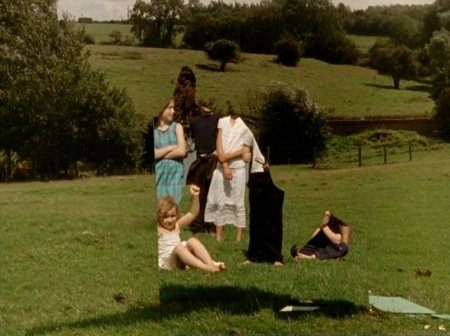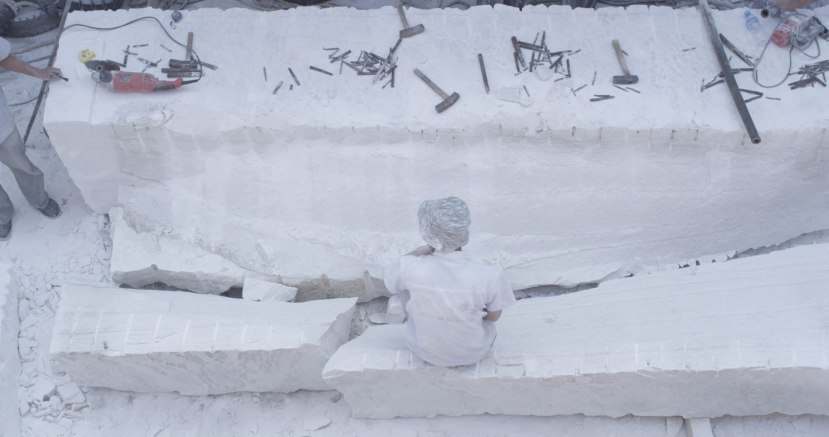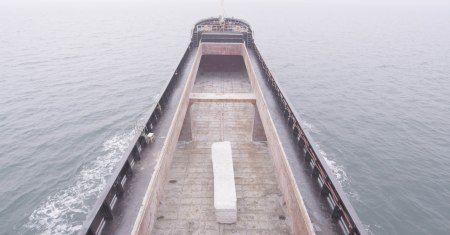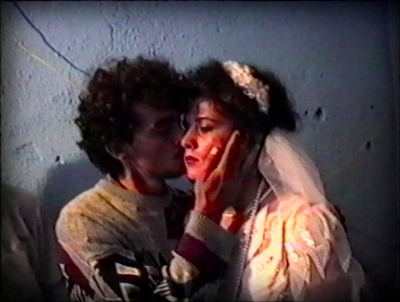In Transit with Adrian Paci
Home to go, 2001, courtesy Peter Blum Gallery, New York.
By Susan Logoreci
We asked artist Susan Logoreci about a recent encounter she had in Montreal with Adrian Paci’s work, which resonated with her on personal and aesthetic levels. Susan lives in Los Angeles where she visualizes urban spaces through colored pencil drawings. Her work is well-known for its ability to recreate the constant motion and flow of the city and surrounding suburbs. She was recently awarded a commission at the Los Angeles International Airport (LAX), and a mosaic based on her drawings will be featured at the Expo/Sepulveda Metro station.
It is my first trip to Montreal, and I am trudging through a freezing cold February day, in a borrowed coat, scarf wrapped around my face, to the MAC (Musée d’art contemporain de Montréal). I am there to see Christian Marclay’s 24-hour film amalgam The Clock. I’d seen bits of it before, but only in the middle of the night where it was all noir sex, death, robberies and creepy people stalking each other—your basic misdeeds. I am curious about what happens in the afternoon, and as it turns out, it’s mostly train rides, waiting rooms and courtrooms.
On the way out of The Clock I wander into the next gallery and out of the corner of my eye I see a video still of a medieval stone bridge. It is so familiar to me; I have been seeing it since before I can remember. Being taken by surprise like that, I have a sudden feeling, like a pinch deep inside.
Only once I fully enter the room and read the signage do I realize that it’s an exhibit by Albania’s most famous contemporary artist, Adrian Paci. I’ve heard of him but hadn’t realized that he was born and raised in Shkodër, the small Albanian village that my father came from. The bridge is called Mes Bridge and never having been to Albania, I only know it from pictures in the books that my father kept in his office.
The video is part of a series on one wall called The Visitors (2011). The videos flip through many slow motion images of a wedding, but the actual ceremony has been removed. What remains in its place is a disconnected ritual of people walking up hills (with Mes Bridge in the background) and shaking hands and just sort of looking around. They are plainly but somewhat formally dressed; serious, glum. Only the kids run around happy, like kids usually do, unaware.
The men in Paci’s video all look like my brother, father and cousins. They remind me of my grumpy father and the few grumpy Albanian refugees I grew up knowing. It’s peculiar to see familiar faces of people I have never met.
Also in this room are two large sculptures. One is Paci’s most well-known piece (Home to Go, 2001) and depicts a man weighed down by a large tile roof. The figure is made from marble and the roof from red tile. The other piece is a large wall that on one side has a brick exterior and on the other interior wall, an extending wooden floor. Home to Go fills the gap in my mind when I think about my father describing his childhood home. It actually looks like the more presentable, Disneyland version of his description, without mouse droppings or the detritus of nine people living in one room. But who wants to bring all that stinky junk into a museum? The sculptures are more like signifiers for the past and what was lost on the journey to whatever came next, than they are objects describing a specific narrative.
On a small screen in the hallway is the first video Paci made (Albanian Stories, 1997). It depicts his young daughter, weaving tales that comingle her stuffed animals and soldiers. It’s funny that I only learn this from the wall text. The daughter speaks in Albanian (a language I don’t understand), and the video is subtitled in French which is also a language I don’t speak. It’s a familiar feeling, getting a glimpse of the meaning and then having to scramble and search for the rest. Even though my father taught Albanian for most of his American life, for the Department of Defense, he never taught his own children because he actively encouraged us to be Americans.
Albanian Stories also makes me think about how scientists are finally learning something that artists and therapists have known for a while. Recent studies suggest that we pass down memories through DNA. The studies have only been done with mice, but if the memories are traumatic or stressful, the offspring have the same fears and biases embedded in their genes. My response to seeing the image of Mes Bridge and Paci’s daughter’s stories may run deeper than one might think.
Per Speculum, 2008, courtesy the artist, Galerie Peter Kilchmann, Zurich and kaufmann repetto, Milan.
Per Speculum, 2008, courtesy the artist, Galerie Peter Kilchmann, Zurich and kaufmann repetto, Milan.
More projection screens are scattered mazelike around the next room of the gallery. Per Speculum (2006) presents children standing and staring at the camera. Suddenly, a boy sends a rock sailing; the image shatters in a loud crash, revealing that we have been looking at their reflections in a mirror. They don’t look like they were expecting this jolt but somehow aren’t shocked by it either. The children then climb a large tree where they are scattered like birds, holding onto the mirror shards that wink and sparkle at us as they reflect sunlight. It’s a magical image, and the fact that it grew out of a somewhat jarring, violent one relays a beautiful, unpretentious sentiment. Inside the Circle (2011) shows a woman with a horse on a lead, going in circles. She is nude and guides the horse in confident, graceful loops. She looks mythical and seems to be having a lot of fun.
Paci’s films and videos are moody, emotionally moving, painterly and strikingly simple.
Next are smaller screens with more wedding images, including Last Gestures (2009). This time we actually see the young bride with fingerless, lacy, 1980’s gloves, big hair and very sad eyes, being kissed on the cheek by the men and boys in her family. Hands rise and fall, briefly stroking hair and faces. The bride turns her head demurely away, accepting each kiss and, I assume, her fate as well. In doing so, she seems strong, resigned and filled with an inner fortitude that she will most likely need.
The Column, 2013, video still, courtesy the artist, Galerie Peter Kilchmann, Zurich and kaufmann repetto, Milan.
The last gallery contains the film Column (2013). It shows the process of mining for marble in China and depicts five Chinese artisans carve it into a Greco-Roman column on board a “factory ship” while the ship is on open water. The film begins with a large piece of marble on the floor of the open freighter. Unformed, it looks like a big chalk pastel. Next, we see the chunk of marble being mined. The earth does not give it up easily. It’s a dusty and dirty business but eventually extracted from the earth with some serious chalky upheaval. Finally, it is on the ship as it pulls away from the harbor and the city skyline recedes.
The Chinese men begin their work of chiseling the marble down. They remove large pieces that hit the floor of the ship with loud, hollow thumps. With unmasked, serious faces covered in fine, white powder, they somehow manage to ignore the choking dust. Their studio is totally open to the elements. Then the subject of the film shifts slowly from the marble to the men. Eventually, we see them cutting and cooking cabbage with a machete in a makeshift kitchen. We see them napping in plastic chairs with their legs carelessly and somewhat dangerously balanced on the railing. The camera lingers on their sandals abandoned in the corner of the temporary studio. Towards the end, there is an amazing shot where the boat stays still and the horizon moves dizzyingly (and somewhat sickeningly) up and down. It gives us an idea of how difficult it must be to accurately cut marble on a moving ship with every nauseating dip and bend. In this moment, the ship also becomes a symbol for finding something steady and sure in yourself as the world tosses you carelessly around.
But then the column in all of its Greco-Roman glory is done. The men are gone and left in their place are a mess of tools and detritus lying around the column and then that’s gone too. The ship continues towards its destination with the completed column in the same position as the unfinished one was upon departure. We are told in the wall text that it is heading to Europe but never see the boat arrive. The film is as much about global commerce as it is about the strength of all the people who dutifully march along, even while finding themselves in strange and difficult circumstances.
The Column, 2013, video still, courtesy the artist, Galerie Peter Kilchmann, Zurich and kaufmann repetto, Milan.
The Column, 2013, video still, courtesy the artist, Galerie Peter Kilchmann, Zurich and kaufmann repetto, Milan.
Paci says, “I am interested in the moment of tension as a metaphor for the world and its state of constant becoming. Vulnerability and fragility are in my opinion, basic human conditions, able to confer beauty and dignity at the same time.” These themes definitely pervade, but the exhibit is also a meditation on loss, identity and memory. These were big topics in art back in the 1990’s when Paci along with all the other Albanians were being liberated from the dictatorship that gripped the country for decades. When Albania became free in 1992, Paci went to Italy to study art. He returned to Albania for a few years to teach art in the late 90’s but the country was so chaotic that he moved his family permanently to Milan in 1997. Although he doesn’t directly narrate his experience, you can see why transformations inspire much of his work.
Last Gestures, 2009, video still, courtesy kaufmann repetto, Milan.
Under Communism, Albanians were not allowed to create art that expressed any individual feelings or ideas. All art was propaganda for the government, and people who rebelled paid a dear price, either ending up in work camps or even killed. When I was growing up, I always heard how Shkodër was a town full of intellectuals, artists, writers and poets. At the end of World War II, those who didn’t escape, like my father had, were rounded-up, imprisoned, tortured and often murdered. The Catholic priests of Shkodër were marched to the cemetery and shot — religion had been banned as well. Basically, culture was crushed and nowhere was it done so more thoroughly than in Shkodër. Who, like my father, wouldn’t be grumpy after all that? Albania was the last European country to fall from Communism and, interestingly, the revolts that ended it began in 1989 in Shkodër.
While the dust settled, many younger Albanians left for the greener pastures of Western Europe and were often met with discrimination in the countries where they settled. Some Albanians resorted to lying about their identity in order to assimilate more easily. For Paci, to want to be an artist as well as an Albanian artist in Milan, I’m sure it took a lot of courage.
In fact, Paci’s exhibition is a meditation on how fate shapes our emotional lives and how people hold on to strength as they are laid bare. It alternates between the beauty people create as well as the violence they are capable of, between powerful people and compliant ones. As a person who grew up with his personal freedom obliterated, Paci creates subtle work about these issues. The exhibit also manages to be straightforward and emotional without being soppy. It’s refreshing to see a body of work that is subtlety compelling without being cool, or ironic, or trendy.
For people who were born in the free world, it’s hard to understand how many generations of Albanians lived with a fear that infiltrated every part of their lives and how it created trauma that still echoes through generations today. Sadly, I know of this firsthand growing up with a father who most likely suffered from undiagnosed PTSD. When people ask about my ethnic background I usually identify myself as a Californian, but even I can’t deny that my father’s Albanian past cast a shadow over my family’s fate.
The final video I see before I exit the exhibit (The Encounter, 2011) is of Paci standing in front of a cathedral, shaking hands with people who have lined up for the privilege. He looks happy and relaxed, as he regards each person, smiles and says something to them that we cannot hear. Welcoming and being welcomed, he has seemingly shed his Albanian grumpiness. Is it possible to overcome the trauma of being a displaced person, a refugee, a political prisoner? Paci’s work tells us there is at least hope that these traumas can be transformed.







